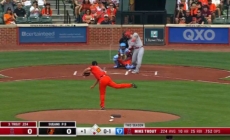-
Fever’s Caitlin Clark scores 32 points in return from injury vs. Liberty - 9 mins ago
-
‘No Kings’ demonstrations across L.A. against ICE sweeps, Trump presidency - 28 mins ago
-
Steelers Defender Fires Off Bold Threat to Browns - 34 mins ago
-
Nolan Gorman crushes three-run home run, extending Cardinals' lead over Brewers - 52 mins ago
-
How to Watch Arkansas vs LSU: Live Stream College Baseball World Series, TV Channel - about 1 hour ago
-
Sydney Sweeney and Michelle Monaghan wow in dresses at premieres - 2 hours ago
-
How to watch the United States vs. Trinidad and Tobago: TV Channel, Time, Live Stream – Gold Cup 2025 - 2 hours ago
-
Gen Z Man Wants To Live off Grid—Buys 7.5 Acres of Colombian Jungle - 2 hours ago
-
Dakota Johnson calls Hollywood ‘a mess’ during ‘Hot Ones’ appearance - 2 hours ago
-
Mike Trout hammers a two-run home run to give Angels lead over Orioles - 2 hours ago
NASA Orbiter Reveals Curiosity Rover Making Tracks Across Mars
NASA’s Mars Reconnaissance Orbiter has taken the first ever photograph of the Curiosity Rover making tracks—both literally and metaphorically—across the Red Planet’s surface.
Captured by the Orbiter’s High-Resolution Imaging Science Experiment (HiRISE) camera, the shot was taken on February 28 this year; this was the 4,455th day of Curiosity’s mission after it touched down on Mars on August 6, 2012.
In the image, the intrepid rover appears as a dark speck at the end of a long trail of tracks, spanning some 1,050 feet, leading to the base of a steep slope that it has since ascended.
Curiosity was en route to the next science stop on its exploration—a region believed to contain “boxwork” sedimentary formations that may have been made by groundwater billions of years ago—which it should reach within a month or two.
The tracks left in the rover’s wake, meanwhile, are expected to linger for a few months before being erased by the Martian wind.
NASA/JPL-Caltech/University of Arizona
The tracks in the newly released image actually represent around 11 individual drives undertaken by the rover, beginning on February 2, when it departed the Gediz Vallis channel.
While Curiosity can trundle along with a top speed of 0.1 miles per hour, the time that it takes to reach a given destination is dependent on various factors, including how difficult the terrain is to navigate and the path plotted out by its software.
The job of planning each day’s trek falls to engineers and scientists at NASA’s Jet Propulsion Laboratory (JPL) in Southern California.
“By comparing the time HiRISE took the image to the rover’s commands for the day, we can see it was nearly done with a 69-foot drive,” said JPL Curiosity planning team chief Doug Ellison in a statement.
The Mars Reconnaissance Orbiter, which began its science mission in orbit around the Red Planet in November 2006, was designed to study the geology and climate of Mars, alongside providing support for other Mars missions.
The HiRISE instrument, designed to capture images in the optimum resolution, actually takes the majority of its images in black-and-white, with just a strip of color running down the middle of the capture.
While the camera has captured Curiosity in color previously, this time the rover happened to fall within the monochrome part of the image.
Do you have a tip on a science story that Newsweek should be covering? Do you have a question about Mars? Let us know via science@newsweek.com.
Source link






























